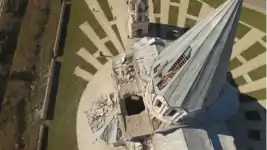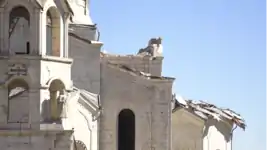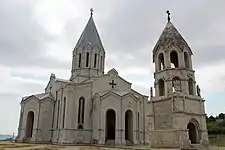2020 Ghazanchetsots Cathedral shelling
The 2020 shelling of Ghazanchetsots Cathedral took place during the Battle of Shusha on 8 October, when the Holy Savior Cathedral (Armenian: Սուրբ Ամենափրկիչ մայր տաճար, romanized: Surb Amenap′rkich mayr tachar) of the city of Shusha, known as Ghazanchetsots Cathedral (Ղազանչեցոց, Azerbaijani: Qazançı), was struck twice by the missiles, resulting in the collapse of a part of the roof.[1][2][3] Armenia accused the Azerbaijani Armed Forces over the shelling.
| 2020 Ghazanchetsots Cathedral shelling Armenian: Սուրբ Ղազանչեցոց եկեղեցու հրթիռակոծություն | |
|---|---|
| Part of 2020 Nagorno-Karabakh war | |
 | |
| Location | Shusha, Nagorno-Karabakh |
| Date | 8 October 2020 |
| Injured | 11 |
| Perpetrator | Azerbaijani Armed Forces (denied by Azerbaijan) |
History
The shelling took place on the 11th day of the 2020 Nagorno-Karabakh war between Armenia and Azerbaijan, a continuation of the Nagorno-Karabakh conflict over the disputed Nagorno-Karabakh region dating from before the fall of communism.[2][4] Shusha was held by the Republic of Artsakh, an ethnic Armenian polity since the First Nagorno-Karabakh War.[2][4] In Azerbaijan, the loss of Shusha in 1992 was especially mourned as the city was the cultural centre of Azerbaijani poets, musicians, and composers.[5][6] Prior to the war, the cathedral had been damaged in ethnic violence surrounding the 1920 Shusha massacre of Armenians and then used as storehouse in the Azerbaijan Soviet Socialist Republic and in the First Nagorno-Karabakh War, until Shusha fell to the Armed Forces of Armenia in 1992.[2][4] The building was then restored in the 1990s by the Armenian Apostolic Church, which had built the church in the 1880s.[4][2]
Shelling
The first shell fell on the dome of the church in the evening of the 8 October, severely damaging the interior.[4][5] Local media reported that adults and children were sheltering inside the church when the first explosion occurred, but no-one was injured.[4] Hours later, as journalists inspected the damage, a second shell struck the building.[4] Two Russian journalists were wounded by the second strike, one, the editor-in-chief of Segodnya, was critically injured and underwent surgery in Stepanakert.[4][7][8][5] An Armenian who accompanied the reporters was lightly injured.[9]
Response
Armenia
Armenia's Foreign Ministry issued an official statement describing it as "another crime of the military-political leadership of Azerbaijan... this action fully fits into its policy of Armenophobia developed for decades. Azerbaijan, which has completely annihilated the Armenian cultural heritage in Nakhichevan and in other parts of the historical homeland of the Armenian people, now throughout the ongoing military aggression against Artsakh is trying to deprive Armenians of Artsakh of their homeland and historical memory".[10] They also stated that "With these actions Azerbaijan replicates the behavior of its newly acquired allies, infamous international terrorist organizations that are responsible for the destruction of numerous historical-cultural monuments in the Middle East".[7] Artsrun Hovhannisyan, spokesman of the defence ministry of Armenia, blamed the shelling on "enemy Azerbaijan".[1]
According to Armenpress, Pargev Martirosyan, the bishop of the Diocese of Artsakh of which the cathedral is the episcopal see, compared the shelling with the actions of Islamic State of Iraq and the Levant, saying "They are bombarding our spiritual values, when we are restoring and preserving mosques".[11][5] Another priest at the cathedral said "I feel the pain that the walls of our beautiful cathedral are destroyed. I feel the pain that today the world does not react to what's happening here and that our boys are dying defending our Motherland".[5]
After the shelling, the Armenian cellist Sevak Avanesyan playing the damaged building. He played the piece "Stork" (Armenian: Krunk) by the Armenian composer Komitas, who was a victim of the Armenian Genocide.[5][12] The music video was posted on October 12 on Armenia’s official Twitter account, which according to Al-Jazeera, was a message that the cathedral’s shelling by Azerbaijan was part and parcel of a centuries-old enmity of Turks towards Armenians.[12]
Azerbaijan
Azerbaijan's Defense Ministry officially denied involvement,[13] while the Azerbaijan state news agency claimed Armenia was behind the attack.[14]
In an interview with BBC News journalist Orla Guerin, the President of Azerbaijan, Ilham Aliyev, denied the church was a military target for his forces and claimed that the shelling was "either it was a mistake of our artillery or it was a deliberate provocation by Armenians themselves".[15] Asked if the same mistake could have been made twice in one day, Aliyev said: "Why not? Have you seen the images of Azerbaijani mosques in the occupied territories? They're all destroyed. They keep pigs in our mosques. We do not attack civilians, unlike them."[15] He also mentioned the 2020 Ganja ballistic missile attacks, blaming Armenia and denying attacking civilians in the Siege of Stepanakert.[15]
International
The United States Commission on International Religious Freedom (USCIRF) wrote that they are "dismayed to learn that the Ghazanchetsots Cathedral was seriously damaged by fighting in Nagorno-Karabakh, and calls for the safeguarding of places of worship and religious sites, particularly amid the current violence".[16]
American composer Daniel Decker, who had given a concert in the building in 2017, lamented the destruction of Facebook, saying "This breaks my heart!"[5]
Aftermath
Azerbaijanis forces seized control of Shusha on 7 November, after a three-day long battle over the city.[17][18][19] On 10 November, a peace agreement was reached between Armenia and Azerbaijan with Russia's mediation.[19][20]
Gallery
 Armenian wedding in damaged Holy Savior Cathedral on 24 October 2020
Armenian wedding in damaged Holy Savior Cathedral on 24 October 2020 The roof of the damaged Ghazanchetsots Cathedral
The roof of the damaged Ghazanchetsots Cathedral Damaged part of the Ghazanchetsots Cathedral
Damaged part of the Ghazanchetsots Cathedral Damaged Ghazanchetsots
Damaged Ghazanchetsots The Ghazanchetsots Cathedral before the shelling
The Ghazanchetsots Cathedral before the shelling
References
- "Nagorno-Karabakh: Armenia accuses Azerbaijan of shelling Shusha cathedral". BBC News. 8 October 2020. Archived from the original on 8 October 2020.
- Demourian, Avet (2020-10-08). "Armenia says cathedral shelled in clashes with Azerbaijan". Associated Press. Retrieved 2020-11-10.
- "Church bombed to ruins - Journalists were injured during second attack – one of them is fighting for his life". bild.de. BILD.de. 8 October 2020. Archived from the original on 8 October 2020.
- "Nagorno-Karabakh: Armenia claims cathedral hit by Azerbaijan shelling". Deutsche Welle. 2020-10-08. Retrieved 2020-11-10.
- "Cellist plays to mourn cathedral shelled in Armenia-Azerbaijan conflict". Classic FM. Retrieved 2020-11-10.
- Freeman, Colin (2020-10-08). "Steeped in blood: the hilltop town at centre of the ethnic feud between Azerbaijan and Armenia". The Telegraph. ISSN 0307-1235. Retrieved 2020-11-10.
- "Church bombed to ruins - Journalists were injured during second attack – one of them is fighting for his life". azatutyun.am. BILD.de. 8 October 2020. Archived from the original on 8 October 2020.
- "Russian blogger Yuri Kotenok heavily injured in Shushi, says Armenian Foreign Ministry". TASS. Retrieved 2020-11-10.
- "Another Journalist Wounded In Karabakh". archive.vn. 2020-10-08. Retrieved 2020-11-10.
- "The statement of the Foreign Ministry of the Republic of Armenia regarding the targeting of the places of religious worship and cultural monuments in Shushi". 8 October 2020. Retrieved 19 October 2020.
- "They bomb our churches, we preserve mosques – Archbishop on Azeri "ISIS-style" attack in Artsakh". armenpress.am. Retrieved 2020-11-10.
- Mirovalev, Mansur (2020-10-15). "Armenia, Azerbaijan battle an online war over Nagorno-Karabakh". Al Jazeera. Retrieved 2020-11-10.
- @wwwmodgovaz (8 October 2020). "#Azerbaijan Army does not target the historical/cultural/ religious buildings and #monuments. This is #Armenia, which hit Imamzade #religious complex on 4th OCT 2020. The claim about Azerbaijan Army's strike on the church in Shusha is unfounded" (Tweet) – via Twitter.
- "Şuşadakı kilsəyə guya raket zərbəsinin endirilməsi ilə bağlı feyk xəbərlərin yayılması Ermənistanın növbəti təxribatıdır". azertag.az. Azerbaijan State News Agency. 8 October 2020. Archived from the original on 8 October 2020.
- "Nagorno-Karabakh: President Ilham Aliyev speaks to the BBC". BBC News. 2020-11-09. Retrieved 2020-11-10.
- "USCIRF Concerned over Religious Repression in Azerbaijan". USCIRF. Retrieved October 19, 2020.
- "Nagorno-Karabakh: Azerbaijan 'takes key town' in Armenia conflict". BBC News. 2020-11-08. Retrieved 2020-11-10.
- "Nagorno-Karabakh confirms Azerbaijani forces have taken control of key city". The Independent. 2020-11-09. Retrieved 2020-11-10.
- Losh, Jack (2020-11-10). "Angry mob storms Armenia parliament after PM agrees Nagorno-Karabakh deal". The Guardian. ISSN 0261-3077. Retrieved 2020-11-10.
- Demourian, Avet (2020-11-09). "Armenia, Azerbaijan agree to end fight in Nagorno-Karabakh". Associated Press. Retrieved 2020-11-10.